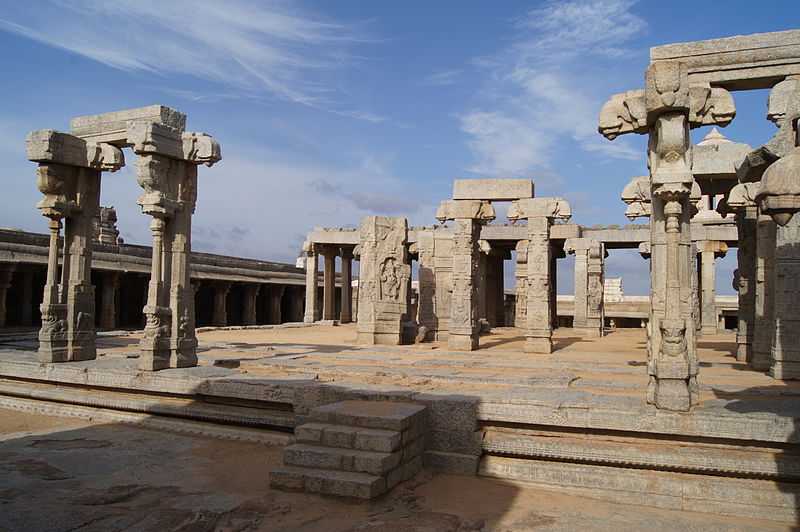"Dream, Dream, Dream! Conduct these dreams into thoughts, and then transform them into action."
- Dr. A. P. J. Abdul Kalam
"Dream, Dream, Dream! Conduct these dreams into thoughts, and then transform them into action."
- Dr. A. P. J. Abdul Kalam
31 May 2024
The village of Lepakshi, located in the heart of Andhra Pradesh, India, is a small town with great historical and cultural significance.
The famous Veerabhadra Temple, dating back to 1583 and dedicated to Lord Veerabhadra, is located here. Built by brothers Viranna and Virupanna, it is one of India’s finest and oldest temples, notable for its Vijayanagar architectural style and exquisite sculptures created by artisans of the Vijayanagara Empire. The temple houses idols of Ganesha, Nandi, Veerabhadra, Shiva, Bhadrakali, Vishnu, and Lakshmi. A major attraction is the huge Nandi bull, carved from a single granite stone, near the main Lepakshi temple. The site is also renowned for being a premier repository of mural paintings from the Vijayanagar Kings, with many ancient Kannada inscriptions on its walls.
This beautiful place never falls short of wonders with its magnificent architectural masterpieces and lively festivals. But when is the best time to visit Lepakshi? Today we will discuss each season's charm and the cultural events that make this place so special.

Spiritual Workers Aligning with People With Faith ~
(Source: Google Images)
Winter Wonderland: November to February ~
The winter season, which runs from November to February, is the ideal time to visit Lepakshi if you want comfortable temperatures and clear skies. During these days' temperatures stay rather comfortable, ranging from 15 to 25 degrees Celsius, making them ideal for touring the village's historical monuments. Veerabhadra Temple in Lepakshi is the most well-known temple in South India because of its magnificent carvings and enormous pillars; therefore, it should be on your list of places to see in the winter. Its beauty is further enhanced during the winter months by the proximity to places of natural beauty where one may go trekking, such as Nandi Hills and Bhoganandeeswara Temple Caves.
Furthermore, this time of year is imbued with joyous sensations, such as Makar Sankranti and Pongal, which bring a plethora of color to our lives through community celebrations that honor long-standing traditions and rituals. These events are worth witnessing at least once.
Spring Serenity: March to May ~

The incomplete Kalyan Mandapa of Lepakshi ~
(Source: Google Images)
Everything here changes color and seeps as winter ends and the warm wind begins to blow. This period lasts from March through May, during which time the temperature gradually rises to a peak of about 35 degrees Celsius. Even though it seems a little warm, there are still a few reasons to visit this location in the summer.
First of all, springtime breathes new life into everything, with flowers blooming everywhere and lush vegetation changing into vivid paintings. This means that springtime offers fantastic photo ops for both nature enthusiasts and photographers to capture the beauty of Lepakshi village at its best. Apart from this, another benefit is that fewer people visit attractions in the summer than in the winter, which allows people to see them leisurely and without much haste.
Summer Sojourn: June to August ~
Every Wall Tells a Different Story ~
(Source: Google Images)
Lepakshi experiences a complete makeover during the summer months, i.e., from June until August, when the mercury rises high and monsoon showers lash this region. While the temperature may touch around 40 C, there are intermittent rains too, which give respite from the burning sun, making the climate pleasant and cool for some time. Visiting Lepakshi while it's raining heavily offers an opportunity to see the ethereal beauty associated with rain-washed landscapes across different parts of the village. In particular, Veerabhadra temple takes on a mystic look altogether during downpours as drops start cascading down ancient walls, creating a wonderful peace-surrounded atmosphere where one can forget everything else except enjoying such calmness around oneself forever.
Fall Fiesta: September to October ~
This Temple Is Full Of Architectural Surprises ~
( Source~ Google Images)
With the arrival of the autumn season, Lepakshi embraces it wholeheartedly. During September and October, the weather remains very pleasant, with temperatures varying between 25 C and 30 C, which makes outdoor activities like trekking, sightseeing, etc. more enjoyable here than any other time of year. In Lepakshi, autumn is a season of celebration. Festivals like Dasara and Deepavali bring happiness and joy to the village. Wherever you look, there are lively street decorations and dazzling fireworks displays. This is a good opportunity for visitors to engage with local customs while eating tasty seasonal dishes.
All in all, Lepakshi never fails to captivate travelers with its timeless beauty and cultural richness throughout the year. No matter if you come here in the mild winter days, vibrant springs, refreshing monsoons, or festive autumns, each season has something different that will leave you spellbound forever. So don't wait anymore. Pack your bags now, because at every corner of this place, history's mysteries are waiting for, along with various cultures and natural scenery that cannot be ignored by anyone who loves traveling.